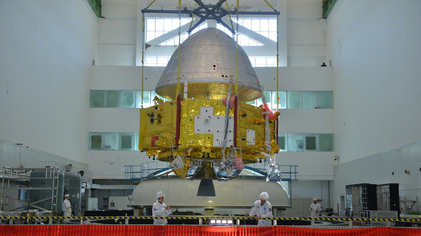Three Nations, China, UAE, and the US, are eager to launch their missions to Mars in a few weeks. Each of these missions is a pathfinder in its own right. Mars is well known to space communities as a graveyard to failed rovers or spacecraft. Besides these failures, a few historic missions to Mars proved successful beyond the Scientist’s imagination and helped rewrite the Red Giant’s understandings. These new missions aim to explore two hidden parts of Mars that never have been seen before.
China’s first exploration of Mars
After successfully launching its mission to the moon, China aims to explore the Red Giant with an orbiter; lander and rover are all packed with around 13 with the most advanced instruments for scientific research. The mission named “Tiawen-1” is scheduled to launch in late July (Last week of July) from an island of Southern China. The word Tiawen stands for the quest of heavenly truth about the planet, which is assumed the next possible home of mankind in our solar system. The spacecraft will reach Mars in February 2021 and conduct a survey of the landing site, its internal structure. Also, the equipment’s onboard will research on Mars atmosphere and surface environment, presence of water, and will find other essential signs for life.
The Chinese government has been tight lip in disclosing information about their Mars voyage. Some researchers from the Chinese Academy of Space Technology in Beijing accepted that this mission to Mars is 1000 times longer and harder than the Chinese journey to the moon; the dense rocks and surface gravity make our mission much riskier and highly challenging.

UAE’s interplanetary hope mission
UAE is set to blast off its orbiter around Mars, named “hope,” which will be the first interplanetary venture of the Arab world. It was scheduled to be launched on 15th July from the Tanegashima Space Centre in Kagoshima, Japan, but due to bad weather and technical concerns, the launch has been halted, and it is supposed to happen in the next two weeks.
The Emirates Mars Mission (EMM) aims to produce the first weather map of the Red Giant. Its huge elliptical orbit will enable the orbiter to observe big chunks of Mars under both day and night timings, covering the entire planet in each 55 hours. Previously, the orbiters around Mars were limited to observe the weather pattern of the planet.
The hope orbiter will reach the Red giant in early 2021, and with the help of three instruments on board, it will study the Mars atmosphere and climate patterns. These observations will give more insights to researchers, from a relatively warm and wet world to a cold, desert planet we know Mars now. That transition was driven by the disposing of Mars’ once-thick atmosphere by the solar wind. The Solar winds are the stream of charged particles flowing from the sun.

NASA’s Perseverance rover to Mars
NASA aims to launch its six-wheeled rover named perseverance, which will collect the Martian rock samples and bring back to earth for further in-depth analysis. As per official recourses, a three-meter long rover will only extract and store rock samples that a future mission will pick up and bring back to earth. The rover is poise to blast off in the last week of July and reach the Red giant in early 2021. Whereas, the mission will possibly end in 2031 when a 2nd mission launch and researchers would have the first-ever sample of the Martian surface. The purpose will allow the researchers to deeply dive into the Martian surface and find an answer to the long-lived question of every curious mind that whether life is possible on Mars and mankind can build colonies there.
For this, the rover is well equipped with research instruments. Basically, perseverance is a copy of NASA’ Curiosity rover with similar sensors and a chemical analyzer that blasts rocks with a laser to identify the atoms and molecules they are composed of. The rover also has a sharp-eyed camera system that can zoom in on areas of interest to produce stereo and 3D pictures.
NASA’s aimed to save money by using the same design of curiosity rover with some tweaks, like adding a system to store samples and upgrading the wheels.
Also, Read: Buzz of the space wonder; Comet Neowise

Saadeqa Khan is the founder, CEO, & Editor-in-Chief of Scientia Pakistan. She’s a member of the Oxford Climate Journalism Network (Second Cohort) and NASW. Saadeqa is a fellow of NPF Washington, The Falling Walls Foundation, and the Science Journalism Forum. Saadeqa has won several international journalism grants and awards for her reports.

